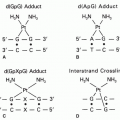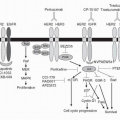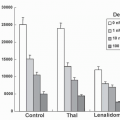Infertility After Cancer Chemotherapy
Angela R. Bradbury
Richard L. Schilsky
During the past 30 years, major strides have been made in the treatment of neoplastic disease with cytotoxic chemotherapy. Progress in understanding tumor cell biology and mechanisms of drug resistance and the introduction of new, effective antineoplastic drugs and technological advances that allow for more detailed and complete molecular profiling and pharmacogenetic studies have all contributed to the successful application of cancer chemotherapy and biotherapy. Many cancer patients now regularly achieve sustained clinical remissions and cures. Moreover, adjuvant chemotherapy is now commonly employed for treatment of micrometastatic disease in clinically well patients with breast cancer, colorectal cancer, lung cancer, and soft tissue sarcoma and prolongs survival for many individuals. Thus, many more patients currently receive chemotherapy than ever before, and, of greater significance, many more are cured, and survive to experience the potential late adverse effects of such treatment. Among these, infertility and mutagenesis are often of particular concern to cancer survivors who have hopes and expectations for a return to normal lifestyle. This chapter will review the effects of cancer chemotherapy on the gonadal function, sexuality, and progeny of patients treated for malignant disease.
Effects of Cancer Chemotherapy on Gonadal Function
Neoplastic disease and its treatment can potentially interfere with any of the cellular, anatomic, physiologic, or behavioral processes that comprise normal sexual function. The nature of the patient’s illness, the extent of necessary surgery or radiation therapy, and the patient’s relationship with spouse and family may all play an important role in reestablishing normal sexual interest and function following treatment for cancer. Further, many drugs used in the treatment of malignant disease have profound and often lasting effects on the testis and ovary. Germ cell production and endocrine function may both be altered, with the magnitude of the effect related to the age, pubertal status, and menstrual status of the patient as well as to the particular drug, dosage, or combination administered.
Chemotherapy Effects in Men
The normal adult testis is an organ composed of diverse and highly specialized cell types, which vary in their sensitivity to cytotoxic drugs. The exocrine function of the gland, spermatogenesis, proceeds in the seminiferous tubules, while the interstitial cells of Leydig carry out the primary endocrine function of the testis, testosterone production.1
Spermatogenesis is a dynamic and complex process that may be divided into three phases: (a) proliferation of spermatogonia to produce spermatocytes and to renew the germ cell pool, (b) meiotic division of spermatocytes to reduce the chromosome number in the germ cells by half, and (c) maturation of the spermatids to become spermatozoa.2 Cytotoxic drugs could potentially effect this process in a number of ways: (a) a specific cell type within the germinal epithelium might be selectively damaged or destroyed; (b) the proliferative and meiotic phases of spermatogenesis might proceed normally, but sperm maturation might be abnormal, leading to functionally incompetent mature spermatozoa; or (c) chemotherapy might damage Sertoli cells, Leydig cells, or other supportive or nutritive constituents of the testis in a way that alters the microenvironment necessary for normal germ cell production.
Clinical Assessment
Testicular function in patients receiving cancer chemotherapy can be evaluated with a careful physical examination, semen analysis, and determination of serum gonadotropin and testosterone levels. Damage to the germinal epithelium frequently results in testicular atrophy. Impaired spermatogenesis also manifests as a decrease in the number and/or motility of sperm present in the ejaculate and an increase in serum follicle stimulating hormone (FSH) level since pituitary gonadotropin secretion is under feedback control by the testis.3 Measurement of Inhibin B, produced by Sertoli cells, has been suggested as an additional marker of testicular damage, although it is not currently recommended for clinical use.4, 5, 6 Leydig cell dysfunction may also occur and is detected by an increase in serum luteinizing hormone (LH) level, and if uncompensated, a fall in serum testosterone level. Subclinical abnormalities of Leydig cell function may sometimes be demonstrated by administration of luteinizing hormone-releasing hormone (LHRH). An excessive rise in serum LH levels in this provocative test suggests the presence of abnormal Leydig cell function.7
Drug Effects on Spermatogenesis
Following exposure to cytotoxic chemotherapy, histopathologic changes occur in the testis, which are independent of the type of drug employed, but related to the total dose administered. The primary testicular lesion caused by all antitumor agents studied thus far is depletion of the germinal epithelium lining the seminiferous tubules.8 Chemotherapeutic agents vary in toxicity to the germinal
epithelium (Table 43-1). In addition, there appears to be a threshold dose for the development of testicular germinal aplasia for each particular drug.
epithelium (Table 43-1). In addition, there appears to be a threshold dose for the development of testicular germinal aplasia for each particular drug.
Drugs Highly Toxic to Male Germ Cells
Among the anticancer drugs, alkylating agents most consistently cause male infertility. Both chlorambucil and cyclophosphamide deplete the testicular germinal epithelium in a dose-related fashion. Patients receiving cumulative doses of chlorambucil in excess of 400 mg are uniformly azoospermic.9 Yet, partial or full recovery of gonadal function may be possible for some individuals, even with cumulative doses above 400 mg.10,11 As with chlorambucil, recovery of gonadal function is possible following treatment with cyclophosphamide, although the probability of recovery appears to be related to the administered dose and few men have recovery when cumulative doses exceed 7.5 g/m2.12 Ifosfamide also appears to have a dose-dependent effect on gonadal function.13,14 Two thirds of men who receive more than 60 g/m2 have evidence of impaired fertility.15 Several small studies have suggested that procarbazine is particularly damaging to the germinal epithelium and may be associated with longer-lasting testicular damage than occurs with the use of alkylating agents alone.16,17 Although vincristine was thought to cause only temporary and reversible damage to the germinal epithelium, at least one study suggests that vincristine itself may have a significant long-term effect on fertility.18 Infertility after cisplatin is also dose dependent. Cisplatin doses less than 400 mg/m2 are unlikely to cause azoospermia,13 whereas almost all patients who receive cumulative cisplatin doses above 600 mg/m2 have severe oligospermia or azoospermia.19 Nevertheless, 50% of men recover spermatogenesis at 2 years and 80% have recovery at 5 years.20 Carboplatin may be associated with less germinal damage than cisplatin.21,22 Among testicular cancer patients, those who received carboplatin-based chemotherapy were 4.4 times more likely to recover spermatogenesis when compared with patients who received cisplatin-based therapy.23
Combination Chemotherapy and Disease-Specific Considerations
Hodgkin’s Disease
As might be expected, combination chemotherapy regimens for the treatment of Hodgkin’s disease that include alkylating agents produce germinal aplasia and infertility in the majority of patients.24 At least 80% of men receiving MOPP (nitrogen mustard, vincristine, procarbazine, and prednisone) combination chemotherapy develop azoospermia, germinal aplasia, testicular atrophy, and elevated FSH levels24,25 and only about 10% of patients receiving MOPP or MVPP (nitrogen mustard, vinblastine, procarbazine, and prednisone) (in which vinblastine replaces vincristine) will ultimately have a return of spermatogenesis.26 Age at chemotherapy does not affect posttreatment sperm counts or recovery in patients who received combination chemotherapy for Hodgkin’s disease and non-Hodgkin’s lymphoma (NHL).27,28 Patients who receive COPP (cyclophosphamide, vinblastine, procarbazine, and prednisone) or ChlVPP (chlorambucil, vincristine, procarbazine, and prednisolone) or BEACOPP (bleomycin, etoposide, doxorubicin, cyclophosphamide, vincristine, procarbazine, and prednisone) have significant gonadal dysfunction as well.29,30
A number of alternative combination chemotherapy regimens to MOPP have now been developed for the treatment of Hodgkin’s disease to minimize long-term toxicities. Among these, ABVD (Adriamycin, bleomycin, vinblastine, and dacarbazine) appears to be less toxic to the germinal epithelium. Azoospermia occurs in only 35% of patients receiving ABVD and recovery of spermatogenesis nearly always follows treatment with this regimen.31,32 Hybrid regimens of MOPP or COPP and ABVD still produce persistent testicular dysfunction, with 60% to 80% of patients experiencing prolonged germinal damage.16,31,33 Other regimens, such as VEEP (vincristine, epirubicin, etoposide, and prednisolone) and VAMP (vinblastine, doxorubicin, methotrexate, and prednisone), are associated with recovery of spermatogenesis in the majority of patients within months or several years of completing chemotherapy.34
Non-Hodgkin’s Lymphoma
Outcomes after treatment for NHL are largely dependent on the cyclophosphamide dose. Regimens containing modest doses of cyclophosphamide such as MACOP-B (MTX-leucovorin, Adriamycin, cyclophosphamide, vincristine, prednisone, and bleomycin) or VACOP-B (vinblastine, Adriamycin, cyclophosphamide, etoposide, prednisone, and bleomycin) (including vinblastine rather than methotrexate [MTX]) produce only transient azoospermia, with recovery of spermatogenesis in 100% of patients at a mean of 28 months after completion of chemotherapy.35 Those who also received pelvic irradiation have more profound and longer-lasting gonadal damage.
Testicular Cancer
Up to 50% of men with testicular cancer have oligospermia at diagnosis.23 In addition, many patients undergo orchiectomy and retroperitoneal lymph node dissection, which is associated with a higher likelihood of azoospermia, oligospermia, and loss of testicular volume when compared with patients who receive orchiectomy alone.36 Patients with testicular cancer treated with cisplatin-based combination chemotherapy uniformly become severely oligospermic or azoospermic soon after chemotherapy is initiated.36,37 Despite this immediate gonadal injury, there appears to be a high degree of reversibility of testicular dysfunction, with as many as 50% of patients demonstrating resumption of spermatogenesis within 2 years of completing chemotherapy.36,38,39 While some studies suggest that recovery of spermatogenesis is rare after 2 years,36,40 recovery of spermatogenesis and fertility has been reported long after completion of treatment.19,41 Higher doses of chemotherapy
generally induce longer-lasting oligospermia.42 As previously described, patients who receive carboplatin-based therapy are more likely to recover spermatogenesis than those who receive cisplatin-based therapy. Other predictors of recovery include normospermia before treatment and less than five cycles of chemotherapy.23
generally induce longer-lasting oligospermia.42 As previously described, patients who receive carboplatin-based therapy are more likely to recover spermatogenesis than those who receive cisplatin-based therapy. Other predictors of recovery include normospermia before treatment and less than five cycles of chemotherapy.23
High-Dose Chemotherapy and Bone Marrow Transplantation
In general, conditioning regimens involving total body irradiation (TBI) appear to have profound effects on fertility, while gonadal recovery occurs in a portion of patients receiving chemotherapy-only conditioning regimens. The majority of men (61% to 90%) regain spermatogenesis within 3 years after single-agent cyclophosphamide.43,44 Early studies of busulfan-cyclophosphamide (Bu-Cy) conditioning regimens using 200 mg/kg of cyclophosphamide, reported a low recovery rate of 17%,43 but more recent studies using a lower dose of cyclophosphamide (120 + 16 mg/kg busulfan) have reported higher rates of recovery, ranging from 50% to 84%.45 Conditioning regimens combining cyclophosphamide with TBI appear to have profound effects on gonadal function, with only 17% of patients recovering spermatogenesis and never earlier than 4 years posttreatment.44
Leydig Cell Dysfunction
Although the effect of chemotherapy on spermatogenesis appears to be the most clinically important, Leydig cell dysfunction may occur as well. While Leydig cells remain morphologically intact after chemotherapy and basal serum LH levels generally remain normal, many patients have been found to have hypersecretion of LH in response to LH-releasing hormone, an indication of subclinical Leydig cell dysfunction.46 The incidence of Leydig cell dysfunction appears to be associated with increasing age and more severe germinal damage.46,47 Partial recovery of Leydig cell function may occur following treatment, although recovery beyond 5 years is unlikely.47 The clinical significance of Leydig cell dysfunction is unclear. Complete androgen deficiency is associated with altered body composition, decreased sexual function, hot flushes, excessive sweating, fatigue, anxiety, depression, and reduced bone mineral density (BMD),48, 49, 50 but mild-to-moderate testosterone deficiency has been less well studied and may be associated with sexual dysfunction,51,52 increased serum cholesterol,53, and decreased BMD.54 Men who receive chemotherapy and have mild Leydig cell dysfunction have lower BMD and increased incidence of truncal fat distribution compared with men without Leydig cell dysfunction.55 Testosterone replacement in men with complete androgen deficiency increases BMD, increases muscle mass, and decreases body fat,56,57 but further investigation is needed to determine the incidence and clinical significance of mild androgen deficiency, as well as the role of replacement therapy.
Mutagenic Potential of Cancer Chemotherapy
In addition to the effects on fertility and Leydig cell function, cytotoxic treatment may be associated with chromosomal abnormalities in germ cells. These alterations may contribute to posttreatment infertility and may place subsequent generations at risk for carcinogenesis or developmental disorders. Up to 19% of sperm from healthy men have chromosomal alterations.58 The frequency of structural abnormalities of sperm in cancer patients receiving chemotherapy or radiation has been estimated at up to 40%, with more damage seen in patients who received multiple chemotherapeutic agents and longer durations of therapy.59,60 It is not clear whether these damaged sperm are able to fertilize eggs. Patients with cancer may also have a higher rate of sperm DNA abnormalities at baseline.61, 62, 63 Animal studies have reported dominant lethal mutations in zygotes after animals were treated with doxorubicin, melphalan, and chlorambucil64,65 and intrauterine death and developmental and morphologic abnormalities in progeny of animals exposed to gonadotoxic chemotherapy.66,67 Nonetheless, human epidemiologic studies have failed to show increased developmental abnormalities or carcinogenesis in the offspring of men who received chemotherapy.68, 69, 70 Many clinicians interpret the transgenerational human studies cautiously, and it is reasonable to counsel men about the potential hazards to their future offspring and discuss contraception for 6 months to 1 year after completion of treatment to allow for clearance of potentially affected germ cells from the reproductive tract.71,72 The absence of transgenerational effects may not apply to offspring conceived by specialized infertility techniques that utilize sperm collected during or soon after chemotherapy, as natural selection at the time of natural fertilization may reduce the likelihood of fertilization by sperm with abnormal chromosomal material.66,67 Thus, some discourage the use of sperm collection and cyropreservation during cancer treatment.72
Assisted Reproductive Techniques for Men
Semen Cryopreservation
Pretreatment sperm banking is presently the only proven means of preserving fertility for men who are to receive combination chemotherapy for cancer. Although pretreatment sperm banking does not guarantee a successful conception in future years, advances in management of male factor infertility have made conception possible for many men. Although approximately 50% of male cancer patients have reduced sperm quality prior to chemotherapy,24,33,73 particularly men with testicular cancer and Hodgkin’s disease,73, 74, 75 the majority of male cancer patients have adequate parameters for sperm storage.76 Only 12% to 17% of referred male cancer patients are unable to donate sperm for cryopreservation because of severe azoospermia before therapy.73,75,77 Even with poor semen quality at the time of cryopreservation, many cancer patients are able to conceive using advanced reproductive techniques.78,79 Therefore, many groups recommend that suboptimal prefreeze sperm analysis should not be used to deny sperm banking, and cryopreservation should be offered to all male patients who have some motile spermatozoa in their sperm sample.76,78,80,81
Although the technology of freezing, preserving, and thawing human semen has advanced considerably, ultimate conception rates using preserved semen have been limited by artificial insemination techniques. Classic intrauterine insemination (IUI) of the female partner using thawed spermatozoa was the only insemination technique available for many years. While IUI has been associated with pregnancy rates of 36% to 45% in male cancer patients,78,82 many male cancer patients have inadequate sperm quantity or quality for this procedure.83 In vitro fertilization (IVF) can be used with low sperm quantity or when female factors prevent successful IUI. IVF has been associated with higher fertilization rates.84,85 The newest advance in fertilization technique is intracytoplasmic sperm
injection (ICSI), which involves the direct injection of a single spermatozoa into the cytoplasm of an oocyte during IVF. This procedure has revolutionized the treatment of male factor infertility and holds particular promise for azoospermic and oligospermic cancer survivors. Clinical pregnancy rates of 50% have been reported with ICSI among male cancer patients.82
injection (ICSI), which involves the direct injection of a single spermatozoa into the cytoplasm of an oocyte during IVF. This procedure has revolutionized the treatment of male factor infertility and holds particular promise for azoospermic and oligospermic cancer survivors. Clinical pregnancy rates of 50% have been reported with ICSI among male cancer patients.82
Testicular Sperm Extraction
Although the majority of patients are able to have sperm collected before therapy, a proportion of male cancer patients are azoospermic before therapy and therefore unable to undergo standard semen collection or fail to have sperm collected before therapy and find themselves azoospermic after treatment. For these patients, sperm may be obtained through newer technologies such as epididymal aspiration or testicular sperm extraction (TESE). With TESE, testicular biopsy tissue is macerated, centrifuged, and examined for the presence of sperm. Recovery rates with TESE in patients with either complete germinal aplasia or maturation arrest on biopsy have ranged from 45% to 76%, presumably because of adjacent areas of intact spermatogenesis.86,87 The reported pregnancy rates with TESE and ICSI range from 30% to 40%.86,87 As this technology is becoming more available, even men with long-standing azoospermia and absent sperm production may be able to father children.
Testicular Germ Cell Transplantation
Testicular germ cell transplantation is an experimental technique that may be available to male cancer patients in the future. Several animal studies have shown that spermatogonial stem cells can repopulate the seminiferous tubules with resumption of spermatogenesis and production of functional spermatozoa, leading to natural live births in the recipient animals.88, 89, 90, 91 Human application has just begun and remains experimental.89




Stay updated, free articles. Join our Telegram channel

Full access? Get Clinical Tree








